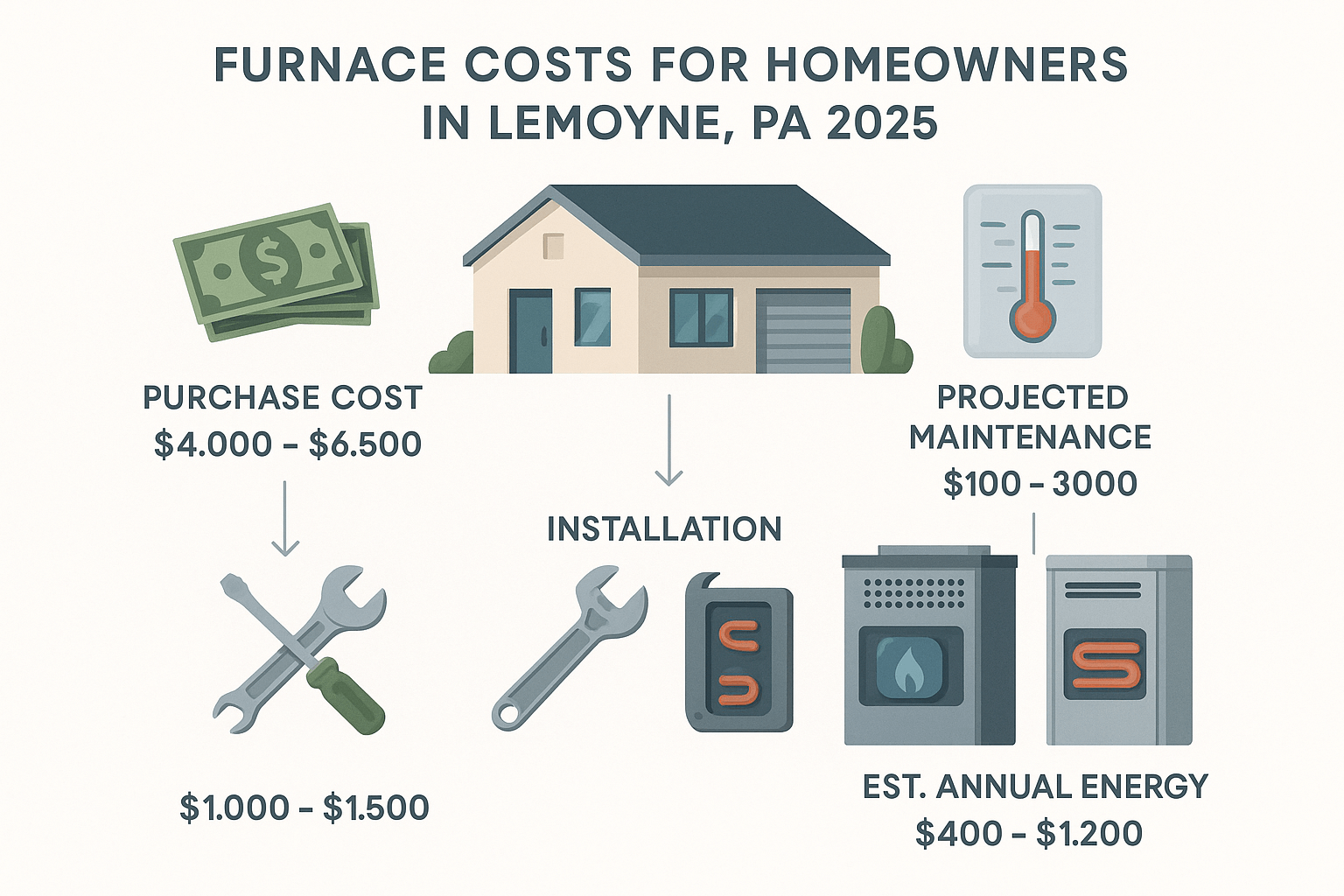Thinking about upgrading your home’s heating system? Knowing the expected costs of furnace installation helps you plan confidently and avoid unexpected expenses. This furnace installation cost guide from Leaps & Bounds is designed to give homeowners clear insights into pricing, installation factors, and long-term value. At Leaps & Bounds, we guide you through every step of the process, from choosing the right system to understanding what drives costs.
Understanding Furnace Costs: What Homeowners Can Expect
When budgeting for a new furnace, it helps to know what drives installation costs and what you can realistically expect to pay. Prices vary, but several consistent factors shape the overall cost.
-
Type of furnace
Gas furnaces are usually more expensive to install because they require proper venting and gas line connections. Electric furnaces tend to have a lower upfront installation cost but may carry higher running expenses depending on electricity prices. -
Size and capacity of the system
Larger furnaces with higher BTU ratings are more costly than smaller models. Accurate sizing is important, as an oversized or undersized system both lead to inefficiency and additional expenses over time. -
Energy efficiency rating
High-efficiency furnaces with superior AFUE scores are more expensive to buy and install. However, the investment can pay off through lower monthly energy bills. -
Condition of ductwork
If ducts need sealing, resizing, or replacement, this will increase the total installation cost. The benefit is a more efficient system with less wasted heat. -
Labor and installation complexity
Every property is different. The location of the furnace, accessibility, and any required upgrades (such as electrical work or safety checks) all influence labor time and costs.

Major Factors That Influence Furnace Install Cost
Several variables contribute to the total furnace installation cost for homeowners:
-
Labor costs
Professional labor is one of the largest parts of overall installation costs. Skilled technicians ensure the furnace is installed safely and correctly, which helps prevent future maintenance and replacement costs. -
System efficiency
Furnaces with higher efficiency ratings often have a higher purchase price. However, improved efficiency reduces ongoing energy bills and can lower furnace costs over the lifetime of the system. -
Home layout and ductwork
The size and layout of a home, along with the condition of existing ductwork, directly affect installation costs. If ducts need modification or repair, this can add to furnace replacement costs. -
Time of year
Seasonal demand influences installation costs, with peak winter months often associated with higher labor costs. Scheduling furnace installation during less busy seasons may help keep furnace costs more manageable.
Understanding how these factors interact makes it easier for homeowners to plan ahead and set realistic expectations for overall furnace replacement costs.
Navigating Additional Furnace Costs and Unexpected Expenses
In addition to the main system cost, there may be other expenses:
-
Electrical upgrades to meet modern system requirements
Modern high-efficiency furnaces often require updated wiring or breaker capacity. If the existing electrical system is outdated, upgrading it ensures safety and compliance but adds to installation costs. -
Thermostat replacements for compatibility with new technology
New furnaces frequently pair best with programmable or smart thermostats. Installing one may involve extra costs but can help optimise energy use and improve comfort in the long run. -
Code and safety compliance adjustments
Local building codes may require adjustments to ventilation, gas lines, or clearances during installation. Meeting these requirements prevents safety hazards and avoids costly penalties. -
Ventilation or ductwork modifications for airflow and efficiency
Ducts that are old, leaky, or undersized may need repair or replacement to handle the new system effectively. Proper airflow not only improves efficiency but also helps maintain consistent heating throughout the home.
For homeowners still learning about furnace installation, understanding the basics of how systems are installed can make it easier to anticipate which additional costs might apply.
Hidden issues such as outdated wiring or damage behind walls can also increase costs once installation begins. Regular maintenance agreements, while optional, can be a cost-effective way to prevent larger repairs and extend system life.
Being aware of these potential additional costs helps prevent surprises and supports accurate project planning.
Expert Tips to Reduce Your Furnace Replacement Cost Without Compromising Quality
There are several practical ways for homeowners to manage furnace costs while still maintaining reliable heating and energy efficiency:
-
Compare furnace models and efficiency ratings
When reviewing furnace installation options, compare models not only by purchase price but also by expected energy savings. A system with a slightly higher upfront cost may lower long-term operating costs, especially with high-efficiency natural gas furnaces that reduce overall energy use. -
Plan installations during off-peak seasons
Labour costs often rise during peak winter months when demand is highest. Scheduling furnace installation in the spring or autumn can sometimes lower the average cost, as HVAC professionals typically have more availability during those times. -
Schedule routine maintenance to extend system life
Regular maintenance helps prevent breakdowns, ensures efficiency, and can delay replacement costs. Homeowners who invest in consistent upkeep often see reduced energy bills, fewer emergency repairs, and longer system performance compared to neglected systems. -
Bundle upgrades for reduced installation costs
Handling related improvements, such as thermostat upgrades or minor ductwork repairs, during furnace installation can be more cost-effective than separate appointments. This approach helps control labour costs and keeps overall furnace installation costs within budget.
By applying these strategies, homeowners can reduce furnace replacement costs without sacrificing system quality or long-term comfort. Considering both installation costs and future energy savings offers the best balance between affordability and performance.
When to Schedule a New Furnace Installation and How Local Specialists Can Help
Recognising the signs that it may be time for a replacement is important. Indicators include:
-
Inconsistent or insufficient heating
Uneven temperatures from room to room often mean the system is struggling to meet your home’s heating needs. This can raise furnace costs over time as the system works harder and less efficiently. -
Frequent or costly repairs
When repair bills begin to approach the average cost of a new system, replacement becomes more economical. Continuing to invest in repairs can drive up overall replacement costs in the long run. -
Rising energy bills despite steady usage
If bills increase even though usage patterns remain the same, the furnace may have lost efficiency. Lower efficiency leads to higher operating costs and is a common sign that a new installation is needed. -
A furnace age of 15 years or more
Older systems are less energy efficient and more prone to breakdowns. Homeowners often find that replacement costs are better value than maintaining outdated equipment. -
Unusual noises or airflow issues
Strange sounds or reduced airflow can signal mechanical problems or ductwork restrictions. These issues not only affect comfort but can also increase maintenance and installation costs if left unaddressed.
Scheduling installation before the peak winter season helps reduce the risk of sudden breakdowns and may offer more flexibility with labour costs and installation timing. Local specialists can also guide homeowners through energy-efficient options that balance upfront furnace costs with long-term savings.
Understanding the True Cost of Furnaces
The cost of furnaces involves more than the purchase price alone. Installation costs, labor, efficiency ratings, and home-specific factors such as ductwork all play a role in the final figure. Additional considerations like maintenance, energy use, and the age or condition of the current system also influence when replacement becomes the most practical option. By weighing both upfront furnace costs and long-term operating expenses, homeowners can make informed decisions that balance budget, efficiency, and lasting comfort.


